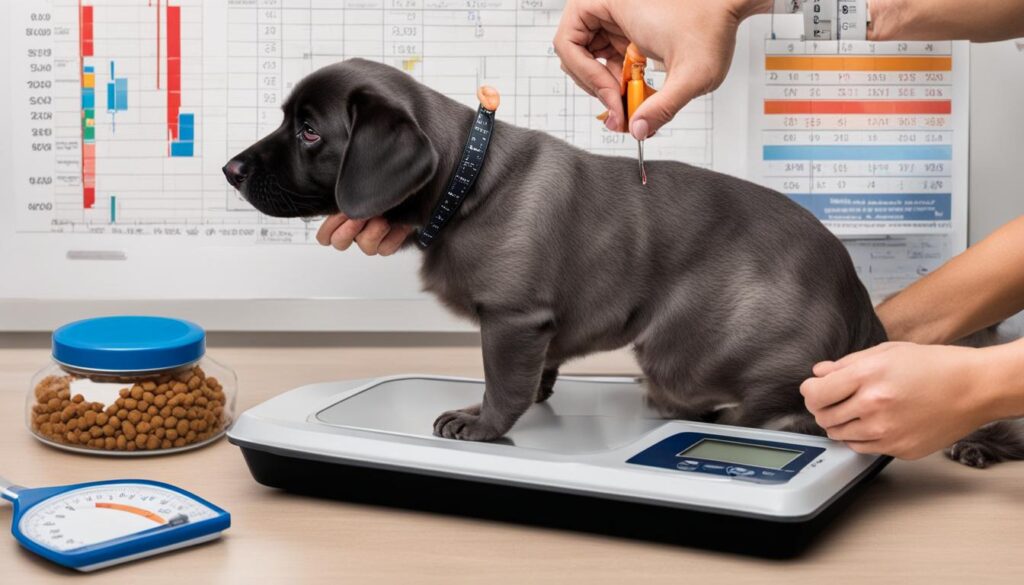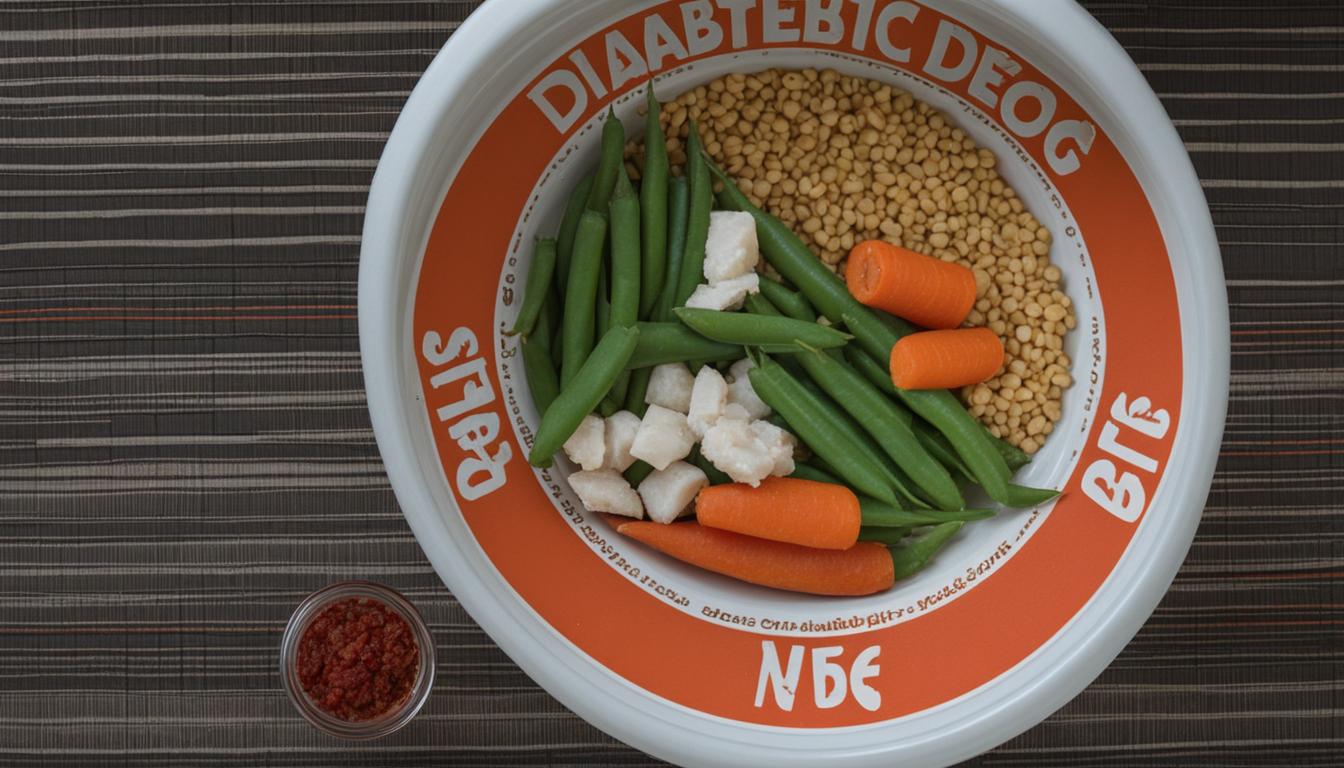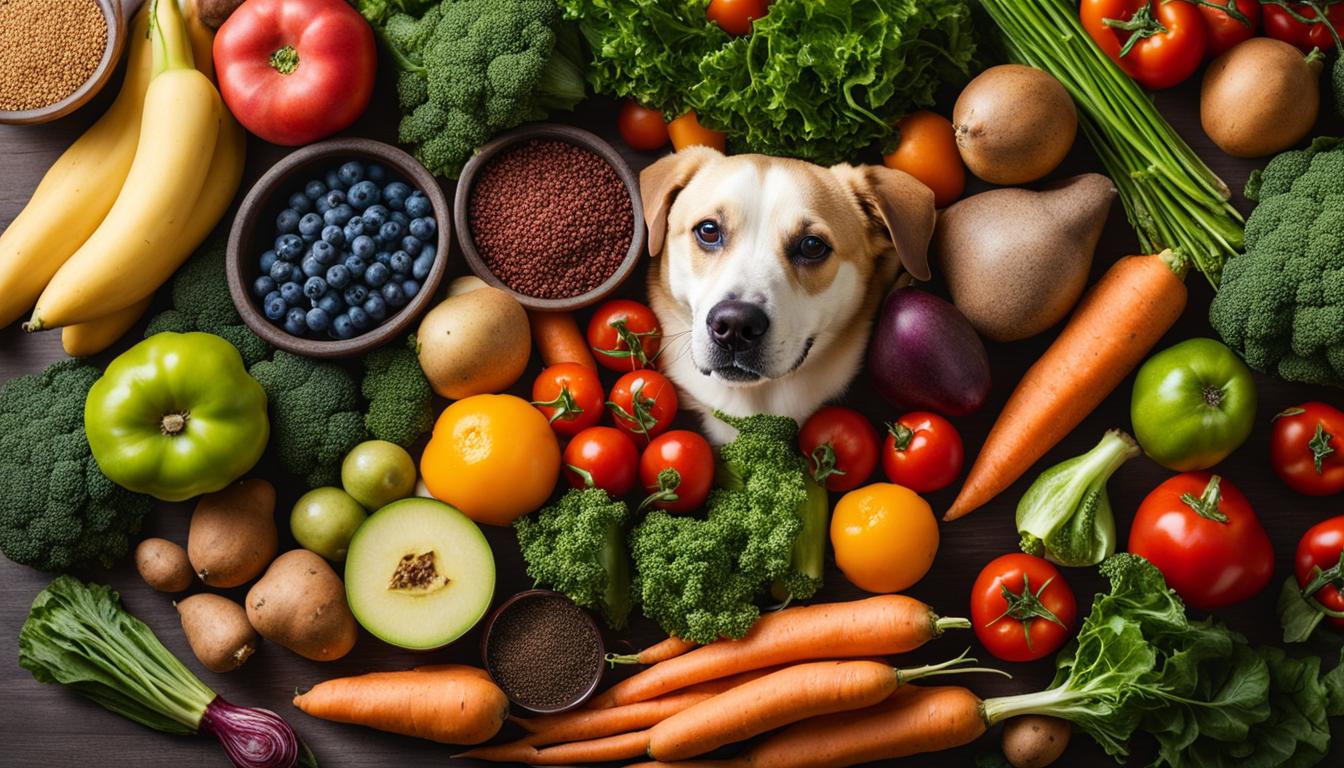Welcome to our guide on diabetic dog diet management! If your furry friend has been diagnosed with diabetes, it’s essential to take proactive steps to manage their condition and ensure their overall health and well-being. In this section, we will provide you with valuable tips and tricks to help you navigate through the world of diabetic dog diet management successfully.
Key Takeaways:
- Managing a diabetic dog’s diet is crucial for their health and well-being.
- Keeping your dog’s weight in check is essential, as shedding extra pounds can help their cells utilize insulin more effectively.
- A high-fiber, low-fat diet is generally recommended to regulate glucose levels and facilitate weight loss.
- Your vet should determine the best diet for your dog based on their individual needs and medical conditions.
- Closely monitor your dog’s food intake and stay in touch with your vet for guidance throughout the process.
Determining Your Dog’s Calorie Needs
When it comes to managing your diabetic dog’s diet, determining their calorie needs is crucial. It is essential to work closely with your veterinarian to determine the exact number of calories your dog should consume each day. Your vet will consider factors such as your dog’s weight and activity level to calculate the appropriate calorie intake.
Following a regular feeding schedule is also important to maintain stable blood sugar levels. Most dogs do well with 2-3 meals a day, spaced approximately 12 hours apart. This consistent schedule helps regulate insulin injections and prevents drastic fluctuations in blood sugar levels.
In addition to their regular diet, your vet may recommend specific diet supplements to aid in managing your dog’s diabetes. These supplements can help promote stable blood sugar levels and overall health. Be sure to follow your vet’s recommendations and consult with them before introducing any new supplements into your dog’s diet.
| Activity Level | Calorie Needs per Day |
|---|---|
| Low Activity | 300-500 calories |
| Moderate Activity | 500-700 calories |
| High Activity | 700-900 calories |
Please note that these calorie ranges are general guidelines and may vary depending on your dog’s individual needs. It is always best to consult with your veterinarian for personalized recommendations.

Why is determining the right calorie intake important?
Monitoring your diabetic dog’s calorie intake is essential for maintaining their blood sugar levels and overall health. Consuming the right amount of calories helps prevent weight gain or loss, both of which can have a significant impact on insulin sensitivity and blood sugar control.
By determining your dog’s calorie needs and following a regular feeding schedule, you can effectively manage their diabetes and provide them with the necessary nutrients for optimal health.
Choosing the Right Diabetic Dog Food
When it comes to managing your diabetic dog’s diet, choosing the right food is crucial. Most veterinarians recommend a high-fiber, low-fat diet to regulate glucose levels and facilitate weight loss. This type of diet helps slow down the digestion process, preventing rapid spikes in blood sugar levels. Many commercially available dog foods are formulated specifically for diabetic dogs, making it easier to find the right option for your furry friend.
In addition to commercial dog foods, prescription diets or homemade diets developed by veterinary nutritionists may also be recommended. It’s important to consult with your vet to determine the best food option for your dog’s individual needs. They can provide guidance on selecting the right brand or help you create a balanced homemade meal plan. Avoid soft, semi-moist dog foods that are high in sugar, as they can disrupt the balance of blood sugar levels.
“Choosing the right diabetic dog food is essential for regulating glucose levels and promoting weight loss.”
To give you a better understanding of the options available, here is a table summarizing some popular commercial diabetic dog foods:
| Brand | Description | Key Features |
|---|---|---|
| Brand A | A veterinarian-recommended brand that focuses on low-sugar, high-fiber formulations. | – Low glycemic index ingredients – Limited ingredient formulation – Balanced nutrition |
| Brand B | A well-known brand that offers a variety of diabetic-specific formulations. | – Controlled carbohydrate content – Added antioxidants and vitamins – Supports weight management |
| Brand C | A prescription-based brand with specialized diets for diabetic dogs with specific medical conditions. | – Tailored nutrition for specific needs – Supports overall health and well-being – Easy digestion |
Note: Always consult your vet before making any changes to your dog’s diet and follow their guidance throughout the process of selecting the right diabetic dog food.
Encouraging Your Diabetic Dog to Eat
If your diabetic dog is not eating well, it can be a cause for concern. However, there are a few tricks you can try to entice them to eat. One option is to add small amounts of canned food to their regular meals. The added moisture and flavor can make their meals more appealing and increase their appetite. Another option is to mix in shredded chicken or scrambled eggs, which can provide a protein boost and make their meals more enticing.
Another way to make mealtime more enjoyable for your diabetic dog is by incorporating low-sodium chicken broth into their food. You can either use it to mix in with their dry food or use it as a base for homemade meals. The broth adds flavor and can help stimulate your dog’s appetite. Just make sure to use a low-sodium variety to avoid any potential health issues.
When it comes to treats, it’s important to choose options that are safe for diabetic dogs. Avoid treats that contain sugars or sweeteners, as they can disrupt the balance of blood sugar levels. Instead, opt for healthier options like dehydrated meats or vegetables. These treats can still be enjoyed in moderation and provide a little something extra to your dog’s diet.
Homemade Diabetic Dog Food Recipe
If you’re interested in making homemade food for your diabetic dog, here’s a simple recipe to try:
“Diabetic Dog Delight”
- 1 cup cooked lean ground turkey or chicken
- 1/2 cup cooked brown rice
- 1/4 cup steamed broccoli
- 1/4 cup steamed carrots
- 1/4 cup low-sodium chicken broth
Mix all the ingredients together and serve to your diabetic dog. This recipe provides a balanced combination of lean protein, fiber-rich grains, and nutrient-packed vegetables. Always consult with your veterinarian before making any changes to your dog’s diet.
Remember, encouraging your diabetic dog to eat is essential for their overall health and well-being. If you’re having trouble getting them to eat, don’t hesitate to reach out to your veterinarian for further guidance and support.
The Importance of Regular Exercise
Regular exercise is a crucial component of managing your diabetic dog’s diet to control their blood sugar levels. Exercise helps your dog maintain a healthy weight, improves insulin sensitivity, and promotes overall well-being. It is important to establish a consistent exercise routine that suits your dog’s capabilities and health condition.
Before starting an exercise regimen, consult with your veterinarian, especially if your dog is on insulin treatment. Your vet may need to adjust your dog’s insulin dosage to prevent blood sugar levels from dropping too low during physical activity. Additionally, they can provide guidance on the appropriate duration and intensity of exercise for your diabetic dog.
Engaging in exercise with your dog can be enjoyable for both of you. Take them for daily walks, engage in gentle play sessions, or participate in activities that are suitable for their age and fitness level. Remember to monitor your dog’s response to exercise and be aware of any signs of fatigue or discomfort.
Benefits of Regular Exercise for Diabetic Dogs:
- Helps maintain a healthy weight
- Improves insulin sensitivity
- Enhances overall cardiovascular health
- Boosts muscle strength and flexibility
- Reduces the risk of other health complications
Regular exercise, along with a proper diet and insulin management, plays a vital role in keeping your diabetic dog healthy and happy. Be sure to track their progress and adjust their diet and exercise routine as needed with the guidance of your veterinarian.
| Activity | Duration | Intensity |
|---|---|---|
| Walking | 30 minutes to 1 hour | Moderate |
| Playtime | 10-15 minutes | Gentle |
| Swimming | 15-30 minutes | Low impact |
Remember, always prioritize your dog’s safety and well-being during exercise. If you notice any unusual symptoms or have concerns about their blood sugar control, consult your veterinarian for assistance.

Monitoring Your Dog’s Progress and Adjusting Their Diet
Monitoring your diabetic dog’s progress is a crucial part of managing their diet and insulin. Regular blood sugar level checks will help you make any necessary adjustments to ensure their health and well-being. Additionally, tracking their weight can provide insights into their response to the diet and help determine if insulin dosage needs to be modified.
Working closely with your veterinarian is essential during this process. They will guide you on how frequently to monitor blood sugar levels and provide recommendations for adjustments. Together, you can create a personalized plan tailored to your dog’s individual needs for insulin management and diet.
When monitoring your dog’s progress, it’s important to keep a record of their daily food intake, insulin injections, and blood sugar levels. This record will allow you to identify any patterns or trends over time and assist your veterinarian in making informed decisions about your dog’s treatment. By closely monitoring their progress and making necessary adjustments, you can optimize their diabetic diet management and ensure a better quality of life for your furry friend.
Table: Example Record Sheet for Monitoring Your Diabetic Dog’s Progress
| Date | Food Intake | Insulin Dosage | Blood Sugar Level |
|---|---|---|---|
| May 1 | 1 cup of diabetic dog food | 6 units | 200 mg/dL |
| May 2 | 1 cup of diabetic dog food | 6 units | 180 mg/dL |
| May 3 | 1 cup of diabetic dog food | 6 units | 220 mg/dL |
By diligently monitoring your dog’s progress and collaborating with your veterinarian, you can make informed adjustments to their diet and insulin management. Remember, every dog is unique, and finding the right balance may take time. With patience and dedication, you can help your diabetic dog lead a happy and healthy life.

Conclusion
In conclusion, managing your diabetic dog’s diet is essential for their overall health and well-being. By following a high-fiber, low-fat diet and adhering to a regular feeding schedule, you can help regulate their blood sugar levels and maintain a healthy weight.
Working closely with your veterinarian and monitoring your dog’s progress will enable you to make any necessary adjustments to their diet and insulin management. Remember, each diabetic dog is unique, so it’s important to tailor their diet to their individual needs.
Consider incorporating low-carbohydrate dog food options into their diet, as they can help further control blood sugar levels. With proper care and attention, your furry friend can lead a happy and healthy life. So, take the necessary steps to ensure your diabetic dog’s diet is well-managed and continue providing them with the love and support they need.
FAQ
How can I determine the calorie needs of my diabetic dog?
Your veterinarian will determine the exact number of calories your diabetic dog needs on a daily basis, taking into account their weight and activity level.
What is the recommended feeding schedule for a diabetic dog?
Most dogs do well with 2-3 meals a day, spaced approximately 12 hours apart. It is crucial to follow a regular feeding schedule to ensure proper management of their blood sugar levels.
Are there any diet supplements that can help manage my dog’s diabetes?
Your vet may recommend specific diet supplements to aid in managing your dog’s diabetes. It is best to consult with your vet to determine the most suitable options for your dog.
What type of diet is generally recommended for diabetic dogs?
Most vets recommend a high-fiber, low-fat diet for diabetic dogs. This type of diet can help regulate glucose levels and facilitate weight loss.
Can I feed my diabetic dog commercially available dog food?
Many commercially available dog foods are formulated to meet the specific needs of diabetic dogs. However, it is important to consult with your vet to determine the best food option for your dog and how to go about switching their diet.
How can I encourage my diabetic dog to eat?
If your diabetic dog is not eating well, you can try adding small amounts of canned food, shredded chicken, scrambled eggs, or low-sodium chicken broth to their regular food to make it more appealing. It’s important to consult with your vet for further guidance.
How important is exercise for diabetic dogs?
Regular exercise plays a significant role in managing diabetes in dogs. It helps maintain a healthy weight, improves insulin sensitivity, and regulates blood sugar levels. However, it is important to consult with your vet before starting any exercise regimen.
How should I monitor my diabetic dog’s progress?
Regular monitoring of blood sugar levels is crucial. It may take time to find the right balance of diet and insulin, so it’s important to check your dog’s blood sugar levels frequently and make adjustments as needed. Working closely with your vet is key to successful management.





